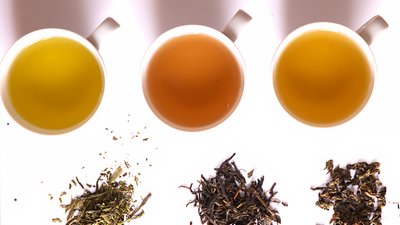Love it or hate it, it looks like sweater weather is going to stick around for a few more months across much of the nation. Which means your appetite for cold water and iced tea has likely waned. But failing to replace these staple fluid sources can lead to dehydration, which wreaks havoc on all parts of your day, especially your workout.
One of the best methods to boost hydration during the chilly time of year is to gravitate toward hot drinks that help warm you head to toe—but not one of the many high-sugar, calorie-rich options. Instead, you'll serve your physique and overall health better if what you sip is a steamy brew of nutritional goodness without any baggage. Luckily, plenty of great options will keep you feeling toasty yet fit when Jack Frost has unleashed his vengeance.
Defrost this winter by making one of these better-body hot drinks, and you won't send your healthy diet into hibernation.
1. White Tea
The Forest Gump of the tea world, this brew has long played the underdog to its green counterpart. But you should know that it's also a drink with steep (get it?) health benefits.
Less processed than green or black tea, white tea is produced when young leaves of the Camellia sinensis plant are allowed to wither and dry for a short period of time without exposure to external heat sources. The upshot is that white tea may retain even higher levels of epigallocatechin gallate (EGCG), the superhero antioxidant for which green tea has been hailed.
Research suggests that EGCG can play a role in improving your waistline, too. In a study published in the European Journal of Nutrition, researchers examined the habitual food and beverage intake of more than 6,000 people across three years and found an inverse relationship between tea consumption and metabolic syndrome symptoms, suggesting consumption can support blood pressure levels and blood glucose levels within a healthy range.[1]

Sip Slowly: When steeped, white tea yields a delicate floral flavor with disappearing sweetness. Those who find green tea too "grassy" should find sipping white tea more agreeable. For the best quality, use loose-leaf white tea such as Silver Needle instead of what's stuffed into a tea bag.
Steep the leaves in water that has been brought to just under a boil, which is effective at maximizing antioxidant extraction and lessening any harsher flavors that boiled water can bring out.[2] Or keep a jar of white tea leaves that have been soaked in cold water in the fridge, and reheat as needed. Research shows that cold steeping for at least two hours results in a brew with a significant antioxidant punch.[2]
2. Rooibos
Rooibos comes from the shrub Aspalathus linearis, a plant indigenous to South Africa. Steamy cups of rooibos have been sipped there for centuries, but only in recent times has the herbal tea made its way across the Atlantic and into U.S. households.
To date, there has been more research conducted on traditional teas, but there is promising preliminary data to indicate that the abundance of antioxidants in rooibos may have a positive impact on bone health while limiting fat-cell growth.[3,4] In its homeland, rooibos has a long tradition of being used to help relieve gastrointestinal woes like diarrhea and nausea.

Sip Slowly: Ruby-hued rooibos is naturally smooth and sweet tasting without any of the bitterness associated with some other teas. In fact, rooibos is so low in tannins, it doesn't become bitter with prolonged steeping. And since it's free of stimulants, it won't upset your sleep routine, so rooibos is a good option for a warm drink on chilly nights. You can find rooibos in tea bags or in loose-leaf form.
3. Ginger
As one of the most influential flavorings in Asian and Indian cookery, the stem of the ginger plant (Zingiber officinale) has long been used to calm queasy stomachs and improve digestion.
Ginger is a rich source of antioxidants, including gingerols, that may exert strong anti-inflammatory tendencies in the body to help dull muscular discomfort in response to lifting weights and other forms of exercise. This is particularly true if you include eccentric training (negatives) or intense running in your weekly exercise routine. Research has found that 2 grams of ginger per day may limit the much-loathed muscle pain associated with each.[5,6]
Additionally, a small pilot study published in the journal Metabolism found that 2 grams of ginger per day may help to curb your appetite.[7] Although more research is needed to confirm these findings, making a toasty ginger brew a part of your day may help you avoid mindless snacking later on.

Sip Slowly: Making peppery ginger tea is as simple as thinly slicing a half-inch of fresh ginger root and steeping it directly in hot water for a couple of minutes. If you like, you can scrape the skin off the ginger with a spoon prior to slicing. You can also add in a squirt of fresh lemon juice or up the ante by steeping it alongside slices of fresh turmeric root.
Another brewing option is to grate ginger on a zester like a Microplane into a mug and add hot water. This can encourage ginger to release more of its flavor and healthy compounds. To make grating easier, store a knob of ginger in the freezer, then grate the frozen piece whenever needed. This also works for recipes that call for minced fresh ginger.
4. Yerba Mate
If you find drinking coffee hard on your stomach, or you're simply not fond of its flavor, but still need a morning jolt and some mental focus, try this national drink of Argentina. Gleaned from leaves of a South American shrub, mate (pronounced MAH-tay) brews up xanthines, a class of compounds that includes the stimulants caffeine, theophylline, and theobromine (the same "happy" chemical present in chocolate). Some people (including me) find that mate doesn't produce the same jitteriness that can come with coffee consumption, but it still packs a powerful energy-boosting punch.
The drink, which has a smoky, grassy taste, has also been shown to contain a few different minerals including manganese, iron, zinc, and copper, as well as chlorogenic acid, a phytochemical also found in coffee that may have a positive impact on weight control.[8]
And if you're trying to keep your buff-to-blubber ratio in check this winter, consider making yerba mate part of your pre-workout staple. A study published in Nutrition and Metabolism discovered that exposure to mate before exercise increased the rate of fat oxidation during the workout.[9]

Sip Slowly: Like other teas, brew mate from tea bags or by steeping the dried loose leaves, with the later providing the most robust flavor. Traditionally, yerba mate is prepared in a container called a gourd and sipped through a metal straw, but a mug will do fine. You can also try steeping the leaves in a French press.
5. Hot Chocolate
What better way to take the edge off the winter chill than snuggling up with a steamy mug of hot chocolate? And, yes, it can actually be a very healthy drink option—as long as you don't rely on the overly processed cocoa mixes sold in a packet or indulge in the sugar bombs served at coffee shops.
The key to making this drink work harder for you is to make it yourself from cocoa powder labeled "raw," "natural," or "unsweetened." Do so, and you'll net a significant antioxidant payload. In fact, researchers at Cornell University determined that a cup of hot water mixed with 2 tablespoons cocoa powder had a greater concentration of antioxidants than a bag of green tea steeped in hot water or a glass of Merlot red wine.[10] That's significant, considering that one of the main antioxidants in cocoa, called epicatechin, appears to play a role in reducing the risk of coronary heart disease mortality in elderly men.[11]

Sip Slowly: For an easy DIY hot chocolate full of rich, cozy yumminess, simply bring 1 cup unsweetened almond milk and 1/4 teaspoon cinnamon to a slight simmer. If you want a little spicy kick, add a pinch of cayenne powder. Add 1 tablespoon natural cocoa powder and 1/2- ounce chopped dark chocolate; whisk vigorously until the chocolate is melted and the mixture is foamy. Pour the drink into a mug.
If you want a creamier drink than cocoa dissolved in hot water, consider using nondairy milk like almond or coconut instead of cow's milk. The proteins found in moo milk may reduce the absorption of antioxidants found in items like cocoa and tea.
References
- Vernarelli, J. A., & Lambert, J. D. (2013). Tea consumption is inversely associated with weight status and other markers for metabolic syndrome in US adults. European Journal of Nutrition, 52(3), 1039-1048.
- Castiglioni, S., Damiani, E., Astolfi, P., & Carloni, P. (2015). Influence of steeping conditions (time, temperature, and particle size) on antioxidant properties and sensory attributes of some white and green teas. International Journal of Food Sciences and Nutrition, 66(5), 491-497.
- Nash, L. A., & Ward, W. E. (2016). Comparison of black, green and rooibos tea on osteoblast activity. Food & Function, 7(2), 1166-1175.
- Sanderson, M., Mazibuko, S. E., Joubert, E., de Beer, D., Johnson, R., Pheiffer, C., ... & Muller, C. J. (2014). Effects of fermented rooibos (Aspalathus linearis) on adipocyte differentiation. Phytomedicine, 21(2), 109-117.
- Black, C. D., Herring, M. P., Hurley, D. J., & O'Connor, P. J. (2010). Ginger (Zingiber officinale) reduces muscle pain caused by eccentric exercise. The Journal of Pain, 11(9), 894-903.
- Wilson, P. B. (2015). Ginger (Zingiber officinale) as an analgesic and ergogenic aid in sport: a systemic review. The Journal of Strength & Conditioning Research, 29(10), 2980-2995.
- Mansour, M. S., Ni, Y. M., Roberts, A. L., Kelleman, M., RoyChoudhury, A., & St-Onge, M. P. (2012). Ginger consumption enhances the thermic effect of food and promotes feelings of satiety without affecting metabolic and hormonal parameters in overweight men: a pilot study. Metabolism, 61(10), 1347-1352.
- Thom, E. (2007). The effect of chlorogenic acid enriched coffee on glucose absorption in healthy volunteers and its effect on body mass when used long-term in overweight and obese people. Journal of International Medical Research, 35(6), 900-908.
- Alkhatib, A. (2014). Yerba Maté (Illex Paraguariensis) ingestion augments fat oxidation and energy expenditure during exercise at various submaximal intensities. Nutrition & Metabolism, 11(1), 1.
- Lee, K. W., Kim, Y. J., Lee, H. J., & Lee, C. Y. (2003). Cocoa has more phenolic phytochemicals and a higher antioxidant capacity than teas and red wine. Journal of Agricultural and Food Chemistry, 51(25), 7292-7295.
- Dower, J. I., Geleijnse, J. M., Hollman, P. C., Soedamah-Muthu, S. S., & Kromhout, D. (2016). Dietary epicatechin intake and 25-y risk of cardiovascular mortality: the Zutphen Elderly Study. The American Journal of Clinical Nutrition, ajcn128819.

